When Solar Panels Need Repair: Warning Signs and Solutions
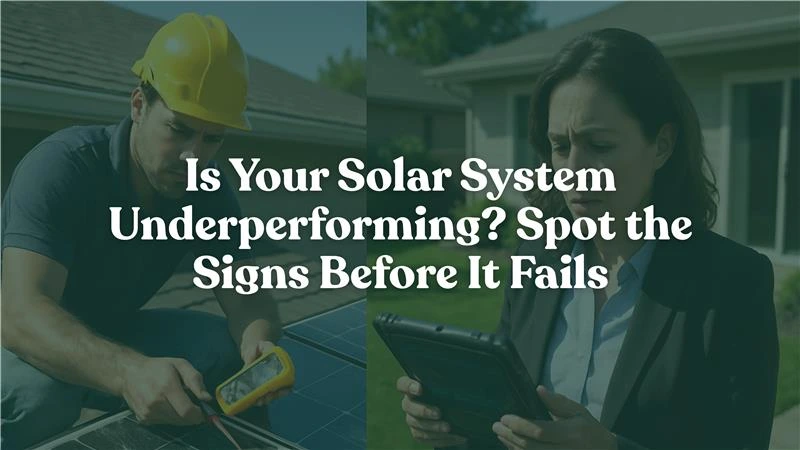
Is Your Solar System Failing? Signs You Need Repairs & What to Do Next
Solar panels are engineered to last 25-30 years, but they’re not immune to damage or performance degradation. Most solar problems can be fixed quickly and affordably when caught early, yet many system issues go unnoticed until they significantly impact energy production and customer satisfaction. For US solar installers and EPCs, recognizing solar panel repair warning signs early and providing effective solutions is crucial for maintaining long-term client relationships and protecting your reputation in the competitive solar market.
The solar industry continues experiencing unprecedented growth, with the global solar EPC market projected to reach $398.92 billion by 2032. However, as more systems come online, demand for reliable maintenance and repair services has skyrocketed, creating both challenges and opportunities for solar professionals who understand how to identify problems before they escalate into costly system failures.
Critical Solar Panel Repair Warning Signs Every Professional Should Monitor
Sudden Energy Production Drops
One of the first signs that something’s wrong with a solar energy system is unexpected decreases in power output or sudden spikes in customer electricity bills. For EPCs and installers, monitoring client systems proactively prevents minor issues from becoming major headaches that damage your professional reputation.
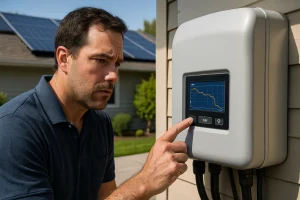
Key performance indicators to track:
- Energy production dropping more than 10% compared to historical data
- System underperformance on consistently sunny days
- Monthly generation falling below manufacturer specifications
- Customer complaints about rising electricity costs despite operational solar systems
Modern monitoring platforms like Enphase Monitoring, SolarEdge Monitoring, and integrated inverter dashboards provide real-time data that makes identifying these trends straightforward. When monitoring tools go offline, you lose visibility into system performance, making regular health checks even more critical for maintaining client satisfaction.
Inverter Malfunctions and Equipment Failures
Your inverter serves as the powerhouse of solar power systems, converting DC power from panels into usable AC electricity. Inverter issues rank among the most common solar system problems, with research showing that one half of inverters fail by year 14, making this a critical area for ongoing monitoring.
Common inverter warning signals include:
- Flashing red lights or error codes on display screens
- Inverter shutting down intermittently or completely offline
- Unusual noises emanating from inverter units
- Overheating or burning odors near inverter locations
Each inverter brand (SolarEdge, Enphase, SMA, Outback) has different indicators, but flashing red lights or inverter fault codes often point to electrical or component failure. Inverters are complex equipment, and professional repair services are essential for maintaining client warranties and system reliability.
Physical Damage Assessment and Environmental Impact
Physical damage to solar panels occurs more frequently than many property owners realize. Environmental factors significantly impact system performance over time, requiring systematic inspection protocols.
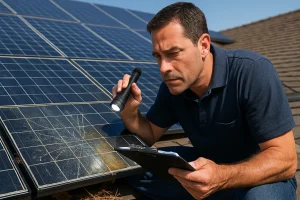
Essential visual inspection checklist:
- Cracked or shattered glass panels allowing moisture infiltration
- Delamination or bubbling in panel surfaces indicating seal failure
- Yellow or brown discolouration of white metallic conductor strips
- Loose or damaged mounting hardware compromising system integrity
- Wildlife nesting under or around panels disrupting airflow
- Debris accumulation reducing light absorption efficiency
The presence of cracks or minor glass fractures can decrease power output by at least 2.5%. Across large commercial installations, even small efficiency losses translate to significant revenue impacts for clients, making regular inspections a valuable service differentiator.
Monitoring System Communication Failures
If solar monitoring systems stop reporting data, determining whether installations continue functioning properly becomes challenging. For solar professionals, this represents both a technical challenge and customer service opportunity that can strengthen client relationships.
Monitoring troubleshooting protocols:
- Verify internet connectivity and communication equipment functionality
- Check for available firmware updates on monitoring hardware
- Test individual panel or string monitoring capabilities
- Validate data transmission between system components
Many customers only discover performance issues when receiving unexpectedly high utility bills, making proactive monitoring services a valuable competitive advantage for EPCs operating in saturated markets.
Advanced Diagnostic Techniques for Solar Professionals
Thermal Imaging and Hot Spot Detection
Hot spots represent one of the most common solar system issues, occurring when panel areas become overloaded and reach high temperatures relative to surrounding sections. Professional-grade thermal imaging equipment identifies these problems before permanent damage occurs.
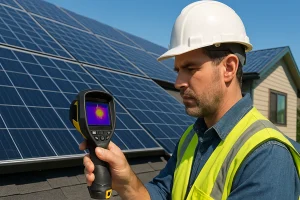
Thermal inspection methodology:
- Conduct scans during peak sunlight hours for maximum accuracy
- Identify temperature variations exceeding 10°C between panel areas
- Document hot spot locations and correlate with electrical measurements
- Schedule immediate repairs for panels showing significant thermal anomalies
If left unchecked, hot spots can cause system degradation or render panels irreparable, making thermal inspection a critical preventive maintenance tool that protects both client investments and contractor warranties.
Comprehensive Electrical Testing
Beyond visual inspections, electrical testing provides deeper insights into system health through systematic analysis of performance metrics and safety compliance measures.
Essential testing procedures include:
- I-V curve tracing to identify underperforming panels
- Insulation resistance testing for safety compliance verification
- Ground fault protection system validation
- String voltage and current measurement analysis
- Power optimizer or microinverter performance evaluation
Effective Solar Panel Repair Solutions and Strategies
Preventive Maintenance Program Development
Regular system monitoring ensures optimal performance throughout operational lifetimes. Successful EPCs build recurring revenue streams through comprehensive maintenance contracts that provide predictable income while strengthening client relationships.
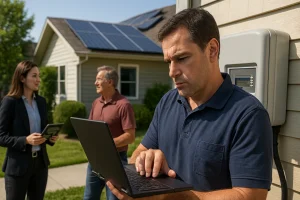
Comprehensive maintenance programs should include:
- Quarterly system performance reviews with detailed reporting
- Annual physical inspections and professional cleaning services
- Proactive component replacement based on manufacturer recommendations
- 24/7 monitoring capabilities with rapid response protocols
Strategic Component Replacement Planning
Despite their critical role, inverters often represent the weakest system component, typically requiring replacement after 10-12 years of operation. Planning for inverter replacement helps clients budget appropriately while ensuring continued system reliability.
Replacement strategy considerations:
- Upgrading to newer inverter technology during scheduled replacements
- Adding battery storage integration during major repair projects
- Implementing panel-level optimization to maximize system performance
- Grid interconnection upgrades meeting evolving utility requirements
Emergency Response Capabilities
Developing rapid response capabilities differentiates professional EPCs from competitors while protecting client investments. System shutdowns for unexpected reasons indicate serious problems requiring immediate professional attention.
Emergency response protocols include:
- 24-hour system restoration guarantees for critical installations
- Pre-stocked replacement parts inventory for common failure modes
- Mobile diagnostic equipment enabling comprehensive field troubleshooting
- Direct manufacturer relationships facilitating warranty service coordination
Industry Trends Shaping Solar Maintenance
The solar EPC landscape evolves rapidly, with advanced technology integration including artificial intelligence and drone surveying enhancing installation efficiency and accuracy. These technological advances also transform professional approaches to system maintenance and repair services.
AI-Powered Predictive Maintenance
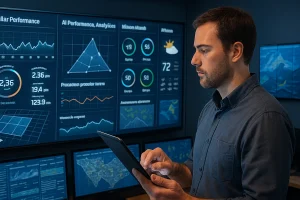
Modern installations increasingly incorporate AI-driven analytics predicting component failures before they occur. This technology enables EPCs to schedule maintenance during optimal weather windows, order replacement parts in advance, and optimize technician routing for maximum efficiency.
Building Long-Term Client Relationships
Damaged solar panels require immediate repair to avoid escalating issues and ensure continued optimal efficiency and safety. For EPCs, this creates opportunities demonstrating value beyond initial installation through comprehensive service offerings and performance guarantees.
Conclusion: Your Partner in Solar Excellence
The solar industry’s rapid growth presents both opportunities and challenges for installers and EPCs. Recognizing solar panel repair warning signs early and implementing effective solutions protects client investments and professional reputations in this competitive market.
At Energyscape Renewables, we understand successful solar installations require ongoing expertise and performance commitment. Our comprehensive maintenance approach combines cutting-edge diagnostic technology with field experience, ensuring optimal system performance throughout operational lifetimes.
Whether you need emergency repairs, preventive maintenance programs, or strategic system upgrades, our certified technicians provide the expertise that EPCs and installers demand across residential, commercial, and utility-scale projects.
Visit Sunscape Solar for comprehensive information on maximizing solar system performance.

sjayakanth@energyscaperenewables.com